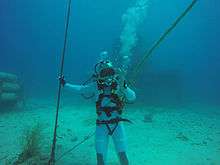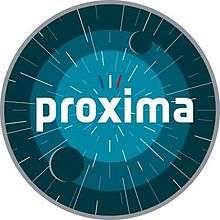Thomas Pesquet
| Thomas Pesquet | |
|---|---|
 | |
| ESA/CNES Astronaut | |
| Nationality | French |
| Status | Active |
| Born |
27 February 1978 Rouen, France |
Other occupation | Engineer, Airline pilot |
Time in space | Currently in space |
| Selection | 2009 ESA Group |
| Missions | Soyuz MS-03 (Expedition 50/Expedition 51) |
Mission insignia |
|
Thomas Pesquet (born 27 February 1978) is a French aerospace engineer, pilot, and European Space Agency astronaut. Pesquet was selected by ESA as a candidate in May 2009,[1] and he successfully completed his basic training in November 2010.[2] From 19 November 2016, Pesquet is part of the International Space Station as a crew member for Expedition 50 and Expedition 51.[3]
Personal life
Pesquet was born in Rouen, France and considers Dieppe his hometown. He is the youngest of two brothers. Pesquet is a black belt in judo and lists basketball, jogging, swimming, and squash as his favorite sports. He is an outdoor and adventure activities enthusiast, and enjoys mountain biking, kite surfing, sailing, skiing and mountaineering. He also has extensive experience with, and holds advanced licenses in both scuba diving and parachuting. His other interests include traveling, playing the saxophone, and reading.
Education
Pesquet graduated from the Lycée Pierre Corneille in Rouen,[4] France, in 1998.
In 2001, he received a master's degree from the École nationale supérieure de l'aéronautique et de l'espace in Toulouse, France, majoring in space systems and space vehicle mechanics. He spent his final year before graduation at the École Polytechnique de Montréal, Canada, as an exchange student on the Aeronautics and Space Master.
Pesquet graduated from the Air France flight school in 2006. This led to an Airline Transport Pilot License-Instrument Rating (ATPL-IR).
He speaks French, English, Spanish, German and Russian, and is a member of the French Aeronautics and Astronautics Association (3AF), and of the American Institute of Aeronautics and Astronautics (AIAA).
Career

From October 2001, Pesquet worked as a spacecraft dynamics engineer on remote sensing missions for GMV, S.A. in Madrid, Spain.
Between 2002 and 2004, Pesquet worked at the French space agency, CNES, as a research engineer on space missions autonomy. He also carried out various studies on future European ground segment design and European space technology harmonization. From late 2002, he was a representative of CNES at CCSDS, the Consultative Committee for Space Data Systems, working on the topic of cross-support between international space agencies.
A private pilot, he was selected in 2004 for Air France's flight training programme. He went on to become a commercial pilot for the French airline, where he started flying the Airbus A320 in 2006. He has logged more than 2000 hours flying time on various commercial airliners, and has qualified as a type-rating flight instructor on the A320, and as a Crew Resource Management instructor.
In ESA

Pesquet was selected as a European Space Agency (ESA) astronaut in May 2009. He joined ESA in September 2009 and successfully completed Astronaut Basic Training in November 2010. Pesquet is the youngest member of the European Astronaut Corps, and the last of the ESA astronaut class of 2009 to arrive to space.
On 10 June 2014, NASA announced that Pesquet would serve as an aquanaut aboard the Aquarius underwater laboratory during the NEEMO 18 undersea exploration mission, which began on 21 July 2014 and lasted nine days.[5][6] He has also taken part in ESA’s CAVES underground course in 2011[7] and NASA’s SEATEST II mission in 2013, furthering his experience in exploration.
In 2014, Thomas was chosen by ESA for a six-month mission to the International Space Station starting in November 2016.[8] Thomas was also the backup to ESA astronaut Andreas Mogensen who flew to the International Space Station on a 10-day flight in September 2015. Pesquet launched from the Baikonur Cosmodrome onboard Soyuz MS-03 on November 17, 2016. He will spend six months on the International Space Station as part of Expedition 50/Expedition 51. Arriving at the ISS on November 19, 2016, he is the first French astronaut since Léopold Eyharts helped installed the Columbus European laboratory module during Expedition 16. His arrival marks the beginning of the European Proxima mission.[9]
The Proxima mission will include 50 science experiment for ESA and CNES. The mission is named after Proxima Centauri, continuing the French astronauts tradition of naming the missions after stars and constellations. The X inside the logo symbolizes that Pesquet is the tenth french astronaut as well as the unknown. Proxima mission name was chosen in a competition, winning name given by 13-year-old Samuel Planas from Toulouse, France. Mission logo was designed by Thomas Pesquet and Karen Oldenburg.[10]
External links
| Wikimedia Commons has media related to Thomas Pesquet. |
- Thomas Pesquet on ESA web site
- Spacefacts biography of Thomas Pesquet
- Thomas Pesquet on Twitter

- ESA astronaut class of 2009's blog
- ESA Brochure about Pesquet and the Proxima Mission
References
- ↑ New class of European astronauts report for training
- ↑ Graduation ceremony for ESA's new astronauts
- ↑ ESA astronaut Thomas Pesquet will fly to the International Space Station in 2016 17 March 2014
- ↑ Lycée Pierre Corneille de Rouen - History
- ↑ "NASA Announces Two Upcoming Undersea Missions". NASA. 10 June 2014. Retrieved 26 June 2014.
- ↑ Bergin, Chris (11 June 2014). "NEEMO returns with two new underwater missions". NASASpaceflight. Retrieved 24 June 2014.
- ↑ "Astronauts cave crew returns to earth". CBS. 21 September 2011. Retrieved 21 September 2011.
- ↑ "ESA astronaut Thomas Pesquet will fly to the International Space Station in 2016". ESA. 17 March 2014. Retrieved 23 March 2015.
- ↑ "ESA Astronaut Thomas Pesquet arrives at the International Space Station". ESA. 19 November 2016.
- ↑ "Proxima Mission Logo". ESA. 12 November 2015.

